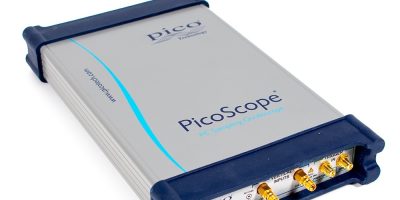30GHz PicoScope updates “revolutionise signal analysis”
Updates and additions to the PicoScope PC-based 9000 series of oscilloscopes by Pico Technology include a new 30GHz bandwidth model and updated 5GHz, 16GHz, and 20GHz models. According to the company, PicoScope is setting new standards in the test and measurement industry.
PicoScope 9000 series consists of two distinct product architectures, both delivering high performance at reasonable prices. The PicoScope 9300 products are direct-to-sampler sequential sampling oscilloscopes of 20GHz and now 30GHz bandwidth. They sample with what is claimed to be market leading 16bit ADC resolution and with timing resolution down to 64 femtoseconds (equivalent sampling to 15TSamples per second), providing more than adequate detail for transitions and impulses down to 12 / 24 ps respectively.
The direct to sampler PicoScope 9400 SXRTO products are real time oscilloscopes that rely upon random equivalent time sampling to support bandwidths of 5GHz and 16GHz. These sample with 12bit ADC resolution and with sampling intervals down to 200 picoseconds (2.5 Tsamples per second), which is more than sufficient detail to address transition and impulse capture down to 22 / 44 picoseconds.
The oscilloscopes capture, measure and characterise RF and microwave signals. The PicoScope 9000s readily address Gigabit data stream quality and RF and microwave modulated envelope and waveshape fidelities, explained Pico Technology, for use in communication and computing networks, imaging, diagnostic, tracking and control systems as well as equipment in homes, cars, pockets, wrists and possibly implants.
Unlike truly transient (single event) real time capture oscilloscopes, Pico said its products do not carry the tremendous cost, footprint and energy consumption burdens or channel sharing compromises of Nyquist-compliant data capture. Instead, they rely on repetitive or clock based signal (as most real world signals are) to build and display precise and statistically rich captures of high speed waveshape and data eyes without sample rate or resolution compromise, across multiple input channels. According to the company, they generally have greater resolution than their more costly transient real time peers can achieve even when they turn to super-Nyquist equivalent time sampling when transient capture data bandwidth proves too costly.
The supplied software includes contoured serial data eye display with auto set-up and mask alignment, histogramming and 30+ statistical measurements to support standard NRZ / RZ eye characterisations, 160+ built in standard protocol masks with hit count, alarms and acquisition control and full polygon user-mask or test limit editing, and with user applied margins for stress testing.
For pulse and waveshape characterisations, the PicoSample software features
100+ IEEE 181 compliant pulse, impulse, transition and waveform auto-measurements, 60+ algebraic, trigonometric, logarithmic, derivative and Boolean trace Math functions, complemented by a comprehensive nested functions equation editor and real, imaginary and vector FFT / IFFT Fourier transforms with six window functions, linear and logarithmic display and a comprehensive set of frequency domain measurements.
There is also broadband modulated envelope characterisations, for which the PicoSample software can build and measure a new live trace that accurately envelopes another (live) amplitude or pulse modulated carrier trace. This is particularly valuable to broadband pulse or data modulator and envelope track amplifier debug and verifications.
PicoScope 9000 Oscilloscopes are available as two or four channel instruments with optional clock from data recovery (to 11.3 Gbits per second, 5.65GHz clock). The 9300 two-channel, 20GHz sampling oscilloscopes can be configured with an integrated 9GHz optical to electrical convertor, or with internal 50 picosecond pulse generators to address single ended or differential TDT / TDR network fault detection and measurements. In these cases, says Pico, PicoSample software supports a comprehensive set of optical and protocol masks, and distance and impedance measurements.
The company said it is committed to offering compact, low-cost, and fully featured broadband oscilloscope solutions with bandwidths ranging from 10MHz to 30GHz.




